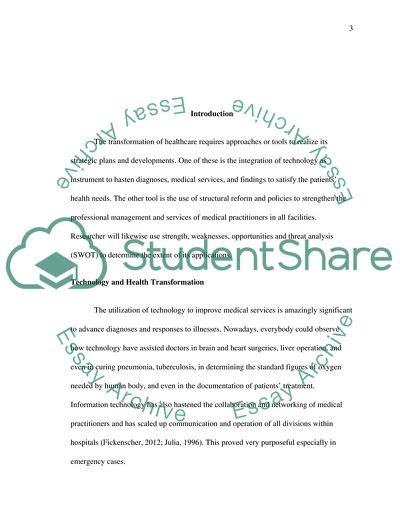Cite this document
(Technology and Health Transformation Coursework - 1, n.d.)
Technology and Health Transformation Coursework - 1. https://studentshare.org/health-sciences-medicine/1790568-compare-and-contrast-any-two-approaches-to-service-design-or-transformation-in-healthcare-setting-using-examples-explore-their-strengths-weaknesses-opportunities-and-threats-these-approaches-may-generate-how-can-they-be-used-in-health-setting
Technology and Health Transformation Coursework - 1. https://studentshare.org/health-sciences-medicine/1790568-compare-and-contrast-any-two-approaches-to-service-design-or-transformation-in-healthcare-setting-using-examples-explore-their-strengths-weaknesses-opportunities-and-threats-these-approaches-may-generate-how-can-they-be-used-in-health-setting
(Technology and Health Transformation Coursework - 1)
Technology and Health Transformation Coursework - 1. https://studentshare.org/health-sciences-medicine/1790568-compare-and-contrast-any-two-approaches-to-service-design-or-transformation-in-healthcare-setting-using-examples-explore-their-strengths-weaknesses-opportunities-and-threats-these-approaches-may-generate-how-can-they-be-used-in-health-setting.
Technology and Health Transformation Coursework - 1. https://studentshare.org/health-sciences-medicine/1790568-compare-and-contrast-any-two-approaches-to-service-design-or-transformation-in-healthcare-setting-using-examples-explore-their-strengths-weaknesses-opportunities-and-threats-these-approaches-may-generate-how-can-they-be-used-in-health-setting.
“Technology and Health Transformation Coursework - 1”. https://studentshare.org/health-sciences-medicine/1790568-compare-and-contrast-any-two-approaches-to-service-design-or-transformation-in-healthcare-setting-using-examples-explore-their-strengths-weaknesses-opportunities-and-threats-these-approaches-may-generate-how-can-they-be-used-in-health-setting.


